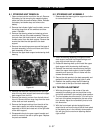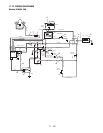
11 - 45
The starter solenoid in the Ariens equipment is a
sealed unit used to actuate the starter motor on the
engines. This solenoid may have three or four
connections.The two large connections carry high
current to operate the starter motor. The small
connections are connected to the coil and carry the
control current.
To check the solenoid, disconnect the cables to the
starter motor, turn the ignition switch to the start
position, and listen for the solenoid to snap inside
contacts closed.
If no snap is heard, check across the coils with a
voltmeter. The voltage should read 12 volts with the
ignition switch in the start position. If no voltage
appears, the defect is in the start circuit.
If the voltage is correct, turn off the power and check
continuity of the coil with an ohmmeter. If the coil is
open, the solenoid is defective and must be replaced.
If the coil has the proper voltage applied, and the
continuity check indicates the coil is intact, the solenoid
plunger is stuck or the contacts are welded shut and
the solenoid must be replaced.
If the solenoid snaps shut, but the start does not
operate, check across the large contacts with an
ohmmeter. If there is no continuity when the solenoid
snaps shut, the contacts are defective and the solenoid
must be replaced.
11.6 LIGHTING CIRCUITS
Lighting circuits are simple circuits and easiest to
trouble shoot in most equipment. They consist of the
lights connected in parallel, a normally open switch, a
protective fuse and a source of power (battery or
engine alternator).
If only one light is out, check the connector, then check
the bulb for continuity (high resistance indicates a
defective or burned out bulb).
If all the lights are out, check the fuse for continuity
(high resistance indicates a defective or blown fuse). If
the fuse is blown, check for a short in the wiring and
correct before replacing the fuse.
If the fuse and lamps are good, check the circuit with
an AC/DC voltmeter.
11.7 FUSES
Fuses are connected in electrical circuits to protect the
circuits from damage due to overload or short circuits.
Fuses are a "weak link" in the circuit. They contain a
metal link designed to melt when a certain current
value is exceeded thus opening or disconnecting the
wiring. Once a fuse blows or melts it must be discarded
and replaced with a new fuse of the same value.
Since the function of the fuse is to protect the circuit,
NEVER attempt to defect the protective device by
bridging or replacing with a device of a higher current
rating.
Electrical testing of these devices is simple, since the
device either conducts current (and is therefore
functioning) or the device is open and is therefore
defective. Use an ohmmeter to check for continuity.
Replace defective devices only with factory
replacements parts.
Figure
50
Figure
51


















